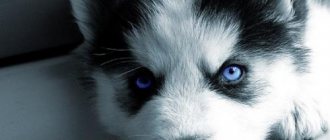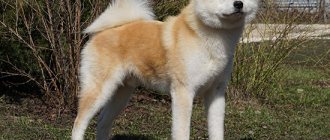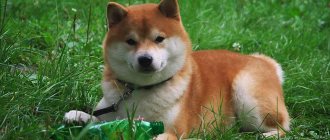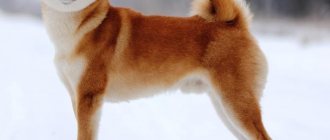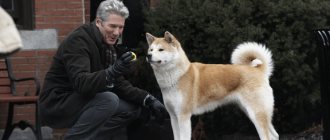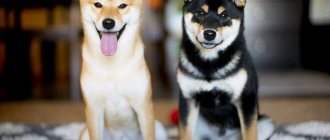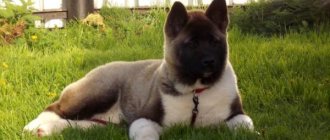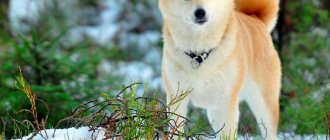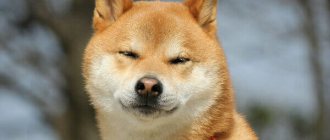Content
Akita Inu is not suitable for apartment living, although some breeders claim that this is possible with sufficient stress. In the house, the dog is taught that the owner’s things are inviolable, and he can take any “animal” belongings.
Need for physical activity
It is better to walk Akita Inu in public places on a leash - it is prone to aggression towards other dogs. At the same time, two hours of active walks a day are required. If there is a place in your city where you can normally walk with your pet without fear of loss or unexpected aggression, the dog will take root in the apartment.
Why you should train your Akita to walk on a leash:
- correct excessive tension on the leash with sharp and short jerks, repeating “don’t pull” or “quiet”;
- step over a trailing leash tangled between the paws;
- bypass obstacles - pillars or trees, on command.
Appearance care
The Japanese Akita's coat sheds seasonally and requires grooming once a week.
It is also important to trim your dog's nails and wash him occasionally.
To care for an Akita Inu, you will need the following tools:
- slicker;
- furminator;
- zoo shampoo;
- large claw clipper;
- Toothbrush;
- massage brush.
A puppy's teeth change at 4 months and require cleaning every two to three days. The plaque is removed with a brush with a special paste. Once a week, the dog is given chewing bones and cartilage to clean its teeth. The eyes are wiped with a cotton pad moistened with water or lotion, such as “Diamond Eyes”. Ear wax is removed 3-4 times a month with a piece of cotton wool wrapped in a bandage. Excessively long claws are carefully trimmed using a nail clipper.
Nutrition
When feeding Akita Inu, you can use a mixed type of food, adding dry food to natural food. But it is easier to use ready-made food of a balanced composition. Akitas are picky eaters, so choosing food can be difficult. In some cases, dogs refuse to eat due to allergies.
When changing food or type of food, it is important to monitor the condition of the dog’s skin, coat, and digestion. The number of feedings determines the age of the dog - two-month-old puppies are fed 5 times, four-month-old puppies - 3 times, adults - 2 times a day
Difference
Most people who don't understand dogs can't always tell the differences between a Shiba Inu and an Akita Inu. But if you put them side by side, the differences will be obvious.
In appearance
The first thing that catches your eye is the size.
| Height (cm) | Height (cm) | |
| Akita Inu | 60-70 | 30-40 |
| Shiba Inu | 35-40 | 8-10 |
Shiba Inu is 2 times smaller. Other differences are less noticeable. The standard provides for the following types of Akita colors:
- red-fawn;
- sesame (wool with black tips);
- brindle;
- white.
The Shiba Inu has the same colors, with the exception of white. In practice, both breeds have all color options.
Dogs have differences in the structure of their coat: the Shiba Inu has a thick coat, but it is tougher compared to the Akita Inu. They also have a thicker and denser undercoat.
In care
Caring for an Akita Inu and a Shiba Inu is not significantly different. The breeds require careful care of their coat. Both species shed twice a year. During this period, Akita Inu and Shiba Inu need daily brushing; at other times, 2-3 times a week is sufficient. The Shiba's coat is less fluffy, which makes grooming easier.
The Shiba Inu is cleaner than the Akita Inu. She is bathed no more than once every six months; an Akita may need 3-4. Both dogs' eyes and ears are regularly wiped with a damp cloth, and the length of their nails is monitored.
Both breeds require the same walking regimen - at least twice a day for 1.5-2 hours. Akita Inu and Shiba Inu need physical activity. It is necessary to let your dog off the leash periodically.
An important difference in caring for the two breeds is nutrition. Not just any dry food is suitable for Akitas. Since they are of truly Japanese origin, rice, fish, seaweed and seafood are more suitable for them. If the owner prefers ready-made food, then, in order to avoid problems with the dog’s health, it is better to consult a veterinarian.
Shiba Inu can eat premium and super premium dry food. You can choose a natural diet for them, but you must carefully observe the proportions: 30% protein to 20% fat.
In price
The cost of Akita Inu and Shiba Inu puppies depends on the class:
- Show. This category includes standard dogs, without flaws. They are used for exhibitions and breeding.
- Breed. Puppies with good reproductive performance, but with slight anatomical deficiencies. They are suitable for breeding, but do not always win at shows.
- Pat. These puppies have deviations from the standard or defects (not life-threatening or health-threatening). They are unsuitable for exhibitions and breeding.
The cost of Akita Inu puppies in Russia varies from 5 to 80 thousand rubles. The presence of a pedigree raises the minimum price to 35 thousand. You will have to pay much more than the average cost for a show-class dog. Pet Akita Inu can be purchased from an ad on the Internet from 10 thousand.
Buying a Shiba Inu will also not be cheap for the future owner; its price is much different from the cost of an Akita Inu - from 15 thousand for a pet to 80 thousand or more for higher classes. The average price in Russia for Shiba Inu puppies is 60 thousand rubles.
Males of both breeds can be purchased for 10 thousand less. Bitches are in great demand, which determines their high price. You can save even more by purchasing an adult dog. But in this case, you need to understand that her character has already been formed and it will be difficult for her to get used to the new owner and environment.
Care and maintenance
Akita Inu is an unpretentious breed of dog. Thanks to their thick undercoat, they can live outside without any problems, but Akita Inus can also be kept in an apartment. However, with the latter option, you need to provide your pet with sufficient physical activity and long walks - about 2 hours twice a day.
Caring for the coat of representatives of the breed is simple - they can be combed approximately once a week, and during periods of shedding - daily. In addition, it is recommended to give your dog special vitamin supplements at this time. Frequent bathing of the Akita is contraindicated, since the protective lubricant of the coat may be washed off. It is advisable to wash your pet no more than 1-2 times a year.
The owner also needs to ensure that plaque and tartar do not form on the pet’s teeth. This can be avoided by brushing your teeth regularly with a special toothbrush. Some dogs categorically deny this procedure - in this case, you can give your pet special bones.
Representatives of the breed also require periodic washing - the face should be wiped with a wet cloth twice a week. Ears should be cleaned once a week using a cotton pad soaked in a special solution. These dogs' nails are usually trimmed 2 times a month. In addition, to naturally wear down the claws, it is recommended to periodically walk your pet on rocky ground or asphalt.
Who is better to choose?
The strong similarity of the two breeds often gives rise to the question of who is better to have, an Akita or a Shiba. When choosing, you need to focus on many factors: place of residence, free time, physical activity, training experience, presence of animals and children.
Akita Inu will be an ideal choice for people:
- living in a private house;
- having no animals or children;
- able to devote a lot of time to the pet;
- looking for a dog to be a guardian and a hunting assistant.
In turn, the Shiba Inu is perfect for those who:
- lives in an apartment;
- physically active (this will be needed during walks);
- able to show patience in training or already has experience;
- contains other animals;
- raises children.
Breed Features
Akita Inu are distinguished by good “vocal” abilities: they make many sounds reminiscent of groans, grunts, and snorts. Dogs can talk to themselves. In relation to strangers, dogs behave with restraint, but wary. If the owner is nearby, they do not show signs of aggression.
Pets are distinguished by the habit of dragging objects in their teeth. They may grab your hands and try to lead you somewhere.
This is more a desire to gain attention than aggression. Dogs take away their own and their owner’s things, and then spend a long time looking for them
They may hide a leash or their toy in the hope that the owner will come to his senses and look for it. This is a kind of game.
Reasons for a dog's tongue sticking out The most incredible, funny and ridiculous laws concerning animals Matriarchy: which animals obey females Pregnancy of cats: instructions for the owner
Akita Inu representatives have an unusual habit of licking themselves like a cat. Cat habits also manifest themselves during hunting. Dogs press down to the ground and wait for the prey to approach, then they attack with a jerk.
Reviews
“I’ve been training Akitas for 7 years. And for me there is no better dog in the world. I can talk about them for hours. Akita is proud and independent, but also an excellent companion. I wouldn’t trade such a dog for any other breed.” Grade:
Maria, Moscow
“When choosing a puppy, we chose a Shiba Inu and have never regretted it. The dog got along well with children and our other animals. Owners of this breed are definitely the happiest owners.” Grade:
Elena, Yaroslavl
“Initially I wanted to buy an Akita Inu. But after getting to know the breed in detail, I decided that for my conditions the Shiba was a more suitable option. The dog is willful, but proper training and patience make it an ideal pet.” Grade:
Kirill 29 years old, Novosibirsk
Source https://sobaka.guru/porody/srednie/otlichit-siba-inu-ot-akity-inu/
Differences between Shiba Inu and Akita Inu
Akita Inu and Shiba Inu are some of the most popular Japanese breeds. These dogs are part of the national culture and have accompanied the Japanese for thousands of years. In Europe, Akita Inu and Shiba Inu are considered truly exotic, so people often do not know how they differ from each other.
Many people consider the differences between breeds to be insignificant, but this is not entirely true. Comparison should be made on the following points:
- origin;
- appointment;
- options;
- color;
- character;
- conditions of detention.
The Akita Inu is a large, Spitz-shaped dog that is one of the fourteen oldest breeds. Archaeologists believe that the ancestors of modern Akita Inu were bred in the second millennium BC and were used for hunting and guarding homes. It is known that in the 19th century they were crossed with mastiffs, which led to an increase in size and a loss of characteristic Spitz-like features. In the 50s, Akitas were actively bred with German Shepherds. The result of such unions was the herding, hunting and fighting varieties.
The Shiba Inu or Shiba Inu was developed about three thousand years ago. Its purpose was to collect shot ducks and accompany the owner on the hunt. Currently, the Shiba is a full-fledged domestic dog and has completely lost its hunting skills. Her main occupation is participating in exhibitions and organizing a company.
If you see these breeds in person, the difference becomes obvious: the Akita Inu has a large stature and strong bones, and the Shiba looks like its miniature counterpart. However, the Shiba is not a small Akita at all, but an independent breed. We can say that this is a dog similar to the Akita Inu, but smaller in size and different in color.
- white;
- red and white (with white masks and areas of the paws and chest);
- brindle.
In addition, Akita Inu are known for physical strength, and Shiba Inu for endurance.
The price for Shib puppies starts from 30,000 rubles. and reaches 60-70 thousand. The cost of an Akita is within the same limits. Private advertisements offer puppies at a very low price - from 8 to 15,000.
Size
Akitas are large, harmoniously built dogs. Their sizes:
- height of males - 64-70 cm, females - 58-64 cm;
- weight of males - 40-45 kg, females - 32-45 kg.
There is also a dwarf Akita, which differs from the standard in its more miniature parameters.
Shiba Inus are compact and suitable for keeping in an apartment:
- height of males - 38-42 cm, females - 35-38 cm;
- weight of males - 9-14 kg, females - 8-13 kg.
Character
Let's look at how the Akita Inu differs from the Shiba Inu, except for size. This is, first of all, character and behavior. Once upon a time, both breeds were hunting breeds, so they have a strong desire for activity and adventure. However, they have a number of noticeable differences.
Akita Inu looks like a reserved and proud dog, but is prone to active games and has a lively character. Akita childhood lasts up to 2.5 years. This period is accompanied by increased curiosity: the dog strives to always be aware of events and instantly reacts to any sound. Over time, she becomes more reserved and prefers to watch what is happening from a soft lounger.
This breed is not prone to aggression, however, hunting instincts can manifest themselves in intolerance towards dogs of the same sex and pets. To avoid unwanted reactions, puppies must be immediately accustomed to interacting with people and relatives. A properly socialized Akita will easily get along with cats and other pets. The dog will be an excellent guard and will never offend his family members. They are smart, loyal and easy to train. These qualities do not prevent the Akita from being self-sufficient and stubborn. She will make excellent company for teenagers, but will not be delighted with the games of children.
The peaceful nature of the dog does not exclude the need for discipline and training. Akita Inu can be very stubborn and strive for independence. Some of them do not accept their own kind and respond with aggression to any attempts to get to know their relatives.
The characteristics of the Shiba Inu are quite contradictory. This breed combines self-centeredness and courage with friendliness and prudence. Shibas are very attached to the family in which they live, but they use every opportunity to impose their own rules. It is better to train puppies with the help of professional dog handlers who can correct behavior in a timely manner and make the animal receptive to the owner’s commands.
Shiba Inu willingly show their affection, but do not tolerate increased attention and constant touching. Dogs remain big puppies for a long time, expressing emotions with grunts, squeals and laugh-like sounds. Barking is very rare for this breed. Shiba Inus do everything depending on their mood: sometimes they try to avoid contact with the owner, and sometimes they follow on his heels.
External signs
Representatives of both breeds have a dense and strong physique. Dogs' paws are straight and move freely. The muzzle is a little plump, elongated, the eyes are narrow, almost triangular. Erect ears have a triangular shape and are one of the most common problems for breeders - puppies often do not “want” to stand up or stand up, but alternately.
The height of adult Shiba Inu does not exceed 40 cm and weighs 10 kg. Akitas are much taller and larger - height reaches 70 cm, weight - up to 40 kg.
Akita and Shiba's coat is thick and short, and Shiba's has 2 layers, and Akita's has 3. Despite this, they do not need the services of a dog groomer; combing is carried out only during periods of heavy shedding. The color can be solid or interspersed with other colors. Shibs are distinguished by red, tan or black coat colors. Akitas are born with brindle, fawn and sesame coat colors. There are both pure white and pure black representatives of both breeds.
Important! Black Akita Inu puppies belong to the “marriage” category. At exhibitions such dogs are disqualified, the price for such a puppy can be reduced by 2 times.
Standard for puppies
Breeders should be aware that representatives of this breed achieve external and internal development only by the age of three.
Small Akita Inus look like teddy bears. In the first month they have a different color from their parents, with the exception of tiger fur, but in the first molt it is restored.
The ears are drooping up to 2-4 months, and they may not stand up at the same time, but this is restored over time. Also, if the erection of the ears coincides with the period of changing teeth, then this process may be delayed.
The body of babies is round and plump, but as they grow older and gain weight, this will change. The fur is soft and fluffy. The tail resembles a small donut.
For puppies, it is important to monitor the correspondence of weight and height and the time of its development:
- 6 months – height 0.56 m, weight 21 kg, shape becomes close to adults, roundness disappears;
- 10 months – height 0.62 m, weight 25 kg, weight is actively gaining (from 4 to 7 kg per month);
- 12 months – height 0.64 m, weight 30 kg, the dog is not yet an adult, physical development is slowing down, and girls begin to go into heat;
- 24 months – height 0.67 m, weight 40 kg, the body is slowly changing: the chest expands, the appearance becomes toned.
By purchasing a dog like an Akita Inu, you get a balanced and reserved, but at the same time friendly and devoted pet in your home. There are standards for this Japanese breed that are used in all exhibitions and the main disqualifying feature is too long hair.
Appearance Difference
Photo reviews will not help to discern the difference in appearance of Akita Inu and Shiba Inu. But when comparing dogs in person, it won't take long to see the difference. It's all about the size of the breeds - Akita is almost twice as large as Shiba.
The Shiba Inu breed is often called Mini Akita by dog breeders.
| Akita Inu | Shiba Inu | |
| Height | 50-60 cm. | 35-41 cm. |
| Weight | 40-50 kg. | 7-13 kg. |
Read Characteristics of American Bulldogs: amazing reviews from owners
At the same time, dogs retain all proportions. Slightly elongated muzzle, triangular ears, characteristically narrow almost triangular eyes. They have well-developed bones and muscles, and their physique is proportional. Akitas have a thicker coat; they have three layers, while Shibas have only two.
Another obvious difference in appearance is the coloring. Akitas are allowed red-fawn, sesame, brindle and white colors. Shiba Inu: red, black and tan, zoned, white. Black coloring in Akitas is considered a breed defect and a disqualifying sign for competitions; such deviations reduce the price of the puppy by at least half.
Akita Inu breed standard
General description - a large, strong and well-built solid dog with pronounced secondary sexual characteristics and a strong type of constitution. The appearance of the Akita is noble, the dog is modest and has a sense of self-esteem.
Important proportions: ratio of body length to height at withers (11:10). Bitches have slightly longer body length in relation to height than males.
Temperament and behavior: loyal and receptive, reserved temperament.
Head and neck:
- Cranial region:
- The size of the skull is proportional to the size of the body.
- Wide forehead with a distinct groove. There should be no wrinkles.
- The stop (transition from forehead to nose) is definite.
- Facial section:
- The nose is black and large. A slight lack of pigment is allowed only for white, but a black nose is desirable.
- The muzzle is of moderate length, powerful, rounded. The base of the muzzle is wide. It tapers towards the nose, but should not be pointed.
- Straight bridge of the nose.
- The lips fit tightly.
- The jaws are strong, with a perfect scissor bite.
- Cheekbones are moderately developed.
- The eyes are small, almost triangular due to the raised outer corner, set moderately wide and deep. The color is exclusively brown, as dark and deep as possible.
- The ears are thick, well-furred, and relatively small. Triangular in shape, with rounded tips. Set on moderately wide and inclined forward.
- The neck is muscular, thick, without loose skin (dewlap), proportional to the head.
Akitas were bred as hunting dogs
Body and tail:
- The back is strong and straight.
- The loin is muscular and wide.
- The chest is deep, well developed, the ribs are moderately convex.
- The stomach is taut.
- The tail is thick, set high, curled over the back when raised. When lowered, the length of the tail almost reaches the hock joints.
Limbs and movements:
- Forelegs:
- The shoulders are moderately sloping and developed.
- The front legs are perfectly straight, with strong bones.
- Elbows fit tightly to the body.
- Hind limbs: developed, with strong bones, moderate articulation angles.
- The feet are thick, round, with tightly knit toes.
- The movements are powerful, the gait is elastic and stable.
Akita movements are graceful and powerful
Coat and color:
- Guard (integumentary) hairs are hard and straight.
- The undercoat is thick and soft.
- In the area of the panties, on the rump and withers, the hair is somewhat longer. The hair on the tail is longer than on the body.
- Acceptable colors:
- red fawn;
- sesame (red-fawn coat with black tips);
- brindle;
- white.
- All colors except white must have “urajiro” - light hair on the cheekbones, sides of the muzzle, neck, lower jaw, chest, tail, body and on the inside of the paws.
Height and weight:
- Height for males: 67 cm (deviation no more than 3 cm).
- Height for females: 61 cm (deviation no more than 3 cm).
- Weight for males: 34–54 kg.
- Weight for females: 32–45 kg.
The Akita's coat is thick and of medium length.
Disadvantages (severity is assessed by severity):
- deviation from the sexual type (male in the bitch type or bitch in the male type);
- snack or undershot;
- lack of teeth;
- tongue with blue or black spots;
- lightened iris;
- short tail;
- timidity.
Disqualification:
- not erect ears;
- hanging tail;
- long hair (shaggy);
- black mask;
- markings in white color.
Description and characteristics of Akita Inu
The Akita Inu variety, informally known as the Japanese Laika or Husky, is a group of dogs characterized by a strong, muscular build.
Description of the Akita Inu standard:
| Part of the body | Characteristic |
| Head | Triangular with a wide forehead, proportional to the size of the body |
| Nose | Black, square shaped |
| Teeth | Strong, white with correct bite |
| Eyes | Dark brown almond-shaped with close-fitting eyelids, raised outer corners |
| Ears | Triangular, thick, slightly inclined towards the muzzle |
| Neck | Muscular, located at 45° to the horizontal, without skin folds |
| Back | Straight with sloping croup and wide loin |
| Rib cage | Voluminous with a noticeable keel |
| Front legs | Heavy straight with developed shoulders and powerful pasterns |
| Hind limbs | Strong with muscular thighs |
| Tail | Thick, rolled into a ring |
The description of the Akita Inu breed includes the characteristics of the coat, the peculiarity of which is the presence of three layers. The upper hairs are coarse and long. Beneath them is a harsh, shorter coat. The Akita's undercoat is soft and dense. White, red and brindle colors are allowed.
This dog has similar external characteristics to the miniature Shiba Inu, which is sometimes called a mini or dwarf Akita, but is a different breed.
Mixed Corgi and German Shepherd
Corman Shepherd is a dog with a proud face that exudes exorbitant dignity, but with cute short corgi legs. This “mix” is a smart, attentive dog, a friendly and unusually intelligent pet that adores people.
Photo of a cross between a German Shepherd and a Corgi:
From the history of the breed
Most of the world's population learned about Akita Inu dogs after the story of Hachiko gained fame. However, in the country where this breed was bred, in Japan, dogs of this variety have enjoyed the fame of a sacred animal for many years.
Still from the famous film "Hachiko"
Like other breeds that are expensive today, Akita Inu in ancient times were originally kept in the families of simple peasant people. However, something happened, and a little later they acquired a completely different status. They were interested in:
- members of the imperial family;
- aristocracy of that time.
After some time, the ancient Japanese Akita began to be considered a purebred dog, so only emperors and nobles could own it. These animals were no longer available to ordinary people for several reasons:
- due to its uniqueness;
- due to the high cost of their maintenance.
As you can understand, the cost of maintenance was not initially such, however, after changes in the standards for keeping animals adopted by emperors and important officials, peasants could no longer treat this animal as before, as if it were an ordinary dog.
Much has changed since ancient times, but the Akita Inu has only become more admirers.
Interest in Akita Inu continues to this day.
It must also be said that the concept of “the oldest breed” is indeed fair to apply in relation to the Akita Inu. Historians have discovered many remains, genetic analysis of which has shown that they belong to Akita Inu dogs that lived at least about 4 thousand years ago. In addition to specific discoveries by scientists, archaeologists also discovered images from ancient times, which actually depict animals, dogs, very reminiscent in appearance of modern representatives of this breed.
Honshu Island - the cradle of the Akita Inu breed
Of course, for the ears of the non-Asian part of the world's population, the name of the Akita Inu breed sounds unusual and is difficult to perceive. However, if you turn to the Japanese language and parse its meaning according to the words, this is what you get:
- the word “Akita” clearly refers us to the name of a specific Japanese suburb, which is located directly on the territory of the island of Honshu;
- The second part of the name, “inu,” simply means “dog” in Japanese.
If you put the two translated words together, you get “a dog from the Akita province.” This allows us to draw specific conclusions about in which part of Japan this famous breed was most popular and bred. These data are also confirmed by historians and scientists who claim that Japanese Akitas appeared on the island of Honshu back in the 17th century. It should also be noted that from that moment on, external changes did not affect the exterior of the breed.
We can observe these animals now in the same form as the Japanese living 4 centuries ago
The particular rarity of this animal, both in ancient times and now, is that this breed is purebred. In other words, no selection work was carried out to breed it, implying crossing with representatives of other breed varieties.
Already at the beginning of times closer to us, in the twentieth century, a special society was created, which took on the tasks of:
- maintaining the purity of the blood of Akita Inu dogs;
- maintaining the valuable qualities of the breed.
This attitude of society towards this issue and its colossal work contributed to the fact that the breed has reached us in its original form. During World War II, breeding of this breed ceased for a while, but not at all because the breeders were busy at the front. The whole point is that Akita Inu dogs, together with representatives of other breeds, were sent to the front, where they provided all possible assistance and died en masse for humans.
Akita Inu provided all possible assistance to humans during the Great Patriotic War
However, a small number of Japanese Akitas still remain in Japan, which turned out to be enough to:
- preserve the breed;
- eventually recreate it;
- even spread throughout the world.
This issue was dealt with by experienced specialists who had been working with animals of the desired species for many years before the war. Thanks to their efforts, humanity came to know and love the Akita Inu.
Origin
Dogs of both breeds have a common homeland - Japan, where they were originally bred as hunting dogs. The main difference in the origin story is that Shibs were used to guard Buddhist monasteries where they became companions to calm and level-headed monks.
Akitas continued to hunt wild boars and bears, which made them much stronger, more powerful and taller. Representatives of this breed even took an active part in battles during the Second World War, which practically destroyed them as a species.
Today, the population of Akita Inu and Shiba Inu is not endangered; you can buy a puppy either in a nursery or from someone else. It is worth remembering that preference should be given to breeders who can provide the necessary documentation that will confirm the pedigree and good health of the puppy.
Similar articles
Requirements for maintenance and nutrition
The size of an adult Akita Inu, as well as the breed’s unpretentiousness in care, make it possible to keep a smiley dog not only in a country house, but also in a city apartment. The main thing is not to neglect the basic rules and be prepared for the fact that twice a year (usually in the off-season) the dog sheds heavily.
How to care
Even a schoolboy can take care of a representative of the oldest Japanese breed. “Sore spots” are teeth, ears and fur. Below - about everything in order.
- Brushing schedule. Wool is the main advantage of the Akita. And at the same time - the main problem of the owner. In winter and summer, when the pet does not shed, it is enough to comb it with a special brush once every seven days. If the molting period has started, more effort will have to be made: at this time you need to scratch the dog three to four times a week. Otherwise, the wool will crumple, and you will find woolen “presents” on the carpet, armchairs and sofa every now and then. Your pet should be taught to groom from childhood. It is extremely difficult to force adults to cut their hair. But dogs, accustomed to the process from puppyhood, perceive grooming as something ordinary, a matter of course.
- Teeth cleaning. Teeth are the calling card of the breed. The owner must closely monitor that they are healthy and not covered with stones and plaque. Proper feeding and regular brushing are the key to healthy teeth. To clean, you need to purchase a dog toothbrush. But if the animal refuses the hygiene procedure in every possible way, or the owner cannot, for certain reasons, carry it out regularly, you can get by with special sticks. This is a chewable product that, when consumed weekly, helps remove plaque from a dog's teeth and prevents the formation of stones.
- Ear cleaning. This is another mandatory hygiene procedure that must be performed every seven days. A special feature of the breed is its erect ears, which are susceptible to various types of pollution. The ears should be cleaned weekly using an ordinary cotton swab, carrying out the procedure carefully so as not to injure the animal.
It is necessary to bathe the dog once every two to three months, with the obligatory drying of the fur. However, you are unlikely to be able to carry out bathing procedures less often - the Akita loves to jump through puddles and roll around in the mud.
What to feed
The feeding rules that apply to Akitas are practically no different from similar rules for other breeds. First of all, this is a categorical refusal to feed from the table. Even if the pet really asks. But Akitas are cunning and can skillfully play on the owner’s feelings of compassion, which in this case turns out to be completely inappropriate.
- Dry food. The best option is high-quality and balanced food for representatives of this particular breed. It is best to select food in the presence of a veterinarian or based on his recommendations.
- Alternation of food and traditional food. If desired, dry food and traditional human food can be alternated in the Akita's diet. Three to four times a week, one meal of your four-legged friend can be replaced with vegetable or meat broth cooked with white meat (for example, based on chicken breast), cottage cheese, kefir or porridge with dietary meat and vegetables.
- Pure water. Your dog's bowl should always be filled with clean drinking water. Even if the bowl is full, the water needs to be changed to fresh once every two days.
During the molting period, you need to feed your Akita Inu with a special fortified food that promotes the growth of a healthy coat.
Character and psychological portrait of a miniature Akita Inu
It is not enough to study information about the rules of care and feeding; it is also important to familiarize yourself with the characteristics of the breed before letting a new family member into the home
Character and socialization
Representatives of the breed are characterized by the following character traits:
- Devotion. To better understand this quality of character, it is worth recalling the well-known film “Hachiko”. This little Hachiko is truly devoted to his human. By the way, after the premiere of the film, the mini Hachiko dog breed gained even more popularity.
- Restraint. The owner will not have to expect any special manifestation of feelings from this pet, but for his sake he will be ready to do anything.
- Dominance. In a circle of other animals, he will need to show his leadership.
- Activity. The breed is best suited for those owners who prefer to spend time actively, participating in games and jogging.
- A pronounced hunting instinct.
- Friendliness. Akita Inu is always kind to his family.
Akita Inu should not be a leader in relation to the owner, otherwise the dog will not be able to control
Education and subtleties of training
Shiba Inu and Akita Inu training must begin as early as puppyhood. In this case, the following rules must be observed:
- treat your four-legged friend with respect;
- be patient;
- any violations and disobedience should be nipped in the bud.
Important! The Shiba Inu must understand from early childhood that the master is the boss.
How to feel about loneliness
Puppies, like adults, do not easily tolerate loneliness; they need a kind master's hand
It is important for them that the owner is nearby and devotes time to games.
Who is suitable for the dwarf Akita Inu breed?
An owner who has the following qualities can raise an obedient Akita Inu pet:
- decisive and strong-willed in character;
- prefers an active lifestyle;
- responsible, treats the dog like a family member, but at the same time does not let him down.
Important! The Akita Inu is ideal for families with children, because for kids the dog will become a first-class nanny. Shiba Inu dogs do not tolerate loneliness well, they need constant attention
Who is the breed not suitable for?
You should not choose a mini Akita Inu as a pet in the following cases:
- If a person is constantly busy at work and does not have time for long walks with the dog.
- If the owner is weak-willed, he does not know how to respond with a categorical refusal.
- If there are already other pets in the apartment.
Comparison of characters
| Akita Inu | Shiba Inu | |
| Trainability | At a young age you need to put in a lot of effort and time. But an adult dog will flawlessly execute all commands and learn new ones. | Education does not take much time and effort. Compared to Akita, they are more obedient. |
| Communication with children | The danger of dogs to children is exaggerated and is a myth. They are good with children, but do not tolerate brute force and can frighten a child. | Calm and balanced, you can have children without a doubt if you have children at home. |
| Protection | They will never leave their owner in trouble, even if her life is at stake. | They signal well about a potential threat, but the most that such a dog can do is bite the threat on the leg. |
| Attachment | As puppies, they are open to communication and strongly attached to their owner. In an adult dog, it is difficult to discern love, like other emotions. At the same time, they remain very loyal dogs. | This is a one-owner dog that will only maintain partnerships with other family members. |
Akita is more suitable for guarding a private home, Shiba, in turn, will help in hunting small animals. Please note that Shiba does not get along well with cats.
Read The origin of the purebred Alapaha Bulldog breed: characteristics, temperament, training and maintenance
